Our wartime zoo allotment part 1 2009-2013 (Project summary)
Note 2022: Our wartime allotment garden ran from 2009-19; it has now been replaced by a wildflower area as zoo enclosures around it are slowly redeveloped. This blog and research project continue.
(Project summary for NSALG 2013)
Let me introduce you to our allotment. It’s my first allotment garden, one I share with my work colleagues, 150,000 visitors a year and 130 species of exotic zoo animals.
Our tiny allotment plot is rather unusual as its right in the centre of our zoo at Newquay in Cornwall. It’s our living shop window on our research project into how zoos and their associated botanic gardens survived wartime challenges. What happened to zoo animals and their staff in wartime? How did they feed animals without ration books? What challenges will zoos and botanic gardens face in future?
To engage people with this, we have recreated a small 1940s Dig for Victory allotment such as would have sprung up in backyards and workplaces to grow precious extra food during rationing. Ours proves a great talking point across the generations for our visitors, as well as the freshest food for animals feeding and scent enrichment from big cats to small monkeys.
I was given bemused permission by Stewart Muir, our Zoo Director (a keen gardener himself) to dig up a small unused patch of sloping lawn beside the public path past our lion enclosure.
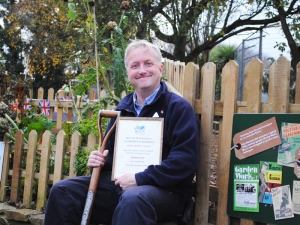
Newquay Zoo’s wartime gardener and blogger Mark Norris with the BIAZA award for best plants in a landscape feature and design.
The garden has been built progressively since 2009, to mark the 70th anniversary of the outbreak of war. In keeping with wartime salvage and very little budget, zoo staff salvaged wood, fencing, sand, old buckets and watering cans from old enclosures being redeveloped around site. We also used lots of zoo poo enriched compost to enrich the hard packed clay soil. We have carried on this thrifty gardening approach since, as we don’t have much of a gardening budget at the zoo these days.
We don’t have a full-time zoo gardener to help and they’d be too busy anyway. Instead lots of staff from different sections have been involved digging, filling sandbags, walling, fencing, listing plants we could use for our animals so its almost “to order”, just a long wait! Varieties are chosen from 1940s lists or earlier, complied from our small archive of diaries, garden publications and colleagues at National Trust Trengwainton Gardens in Penzance (down the road about twenty miles away). Keepers freely harvest crops when they want something fresh from the veg, flowers or herbs for the animals or sometimes the cafe; several staff took especial care of it when I was off sick with pneumonia for months during the rotten wet growing season in 2012. It’s great to be able to involve our Junior Keepers or younger visitors in picking broad bean pods, borage flowers chives rolled into sushi balls for feeding fresh to our monkeys as enrichment.
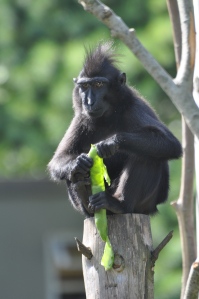
Rare ‘Yaki’ Sulawesi Macaque monkey at Newquay Zoo enjoying fresh broad bean pods, summer 2010. (Picture: Jackie Noble, Newquay Zoo)
Thanks to our zoo maintenance team, it now has a smart permanent fence (to keep out free ranging animals and hungry children), fenced along the path at a height accessible for visitors in wheelchairs or small visitors in pushchairs to feel the plants, smell the herbs, even the lion strength cat nip (cat thyme) gets a laugh at lion talks. So it’s kind of a sensory and wildlife garden too. Despite wartime strictures about flowers, flower creeps into the veg garden to attract beneficial insects and companion planting to protect the veg. If strawberries get eaten, it’s often by visitors, not just birds and slugs, I’m told by other zoo staff.
I call it my 5 minute garden as it gets me outside and away from my desk on an office bound day. I fit in short tasks on coffee breaks, in between zoo duties and in between feeding talks. Five minutes weeding. Five minutes planting, all with a mug of tea in hand. Other staff stop to chat, some also keep an eye on it all or water the veg on my days off etc. though modern hose is preferred on busy days by many to the bucket and stirrup pump I sometimes use (as you can easily ‘accidentally’ soak the front row of children with one of these!)
Everything takes twice as long being in public as it’s a great opportunity to chat to our visitors over the garden fence about their wartime memories as land girls and evacuees. Other days younger visitors tell me about the food they grow at home or in their school gardens, sometimes that they’ve “done the war” at school. They do this sometimes whilst planting up a sunflower in a newspaper pot they’ve made to take home. The children are also usually impressed that CBeebies’ Mr.Bloom popped in one day and visited the garden briefly during a tour event at the zoo (busy day, that was!)
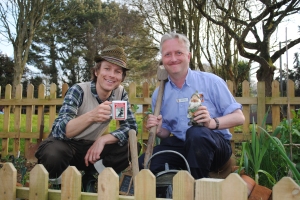
Mr Bloom visits the World War Zoo Dig For Victory wartime garden at Newquay Zoo, 2 April 2012 with project manager Mark Norris.
We love this part of the project, even it makes the garden work take twice as long! As a novice gardener relying on wartime manuals, I’ve had a few ex land girls and old gardeners tell me whilst working in the garden that “you don’t do it like that, son.”
The project has broadened out to involve our sister zoo at Paignton in Devon as it works towards its centenary in 2023. It might have futuristic hydroponic gardens like Verticrop to feed its animals but it also has an interesting wartime past. Paignton Zoo survived having American GIs encamped across the site, who reputedly ate some of its exotic bird life before departing for D-Day. Chessington Zoo was also evacuated there from 1940-45, after it was bombed; we arranged for the BBC to interview an evacuee boy who lived there at the time (extract can be found on BBC Radio Cornwall online). My colleagues Lisa Stroud and Michelle Bales have been looking into developing this project there and research their zoo archives at Paignton Zoo.
Other zoos and botanic gardens around the world have been included by looking at how they fared in the First World war version of Dig for Victory, especially through researching and publishing through our blog the stories behind the names on staff war memorials at London Zoo, Kew Gardens, Chester Zoo and Manchester’s Belle Vue Zoo (now closed) or wartime traces at Birmingham Botanic Gardens.
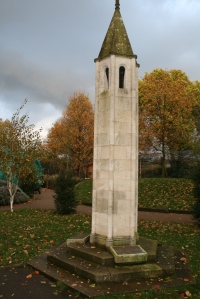
Autumn colours behind the ZSL war memorial, London Zoo, November 2010 (Photo: Kate Oliver, ZSL Education)
Poppy crosses mark the harvested ground each Armistice and we look forward to dedicating a small memorial stone, making this a small peaceful memorial to zoo animals, the staff and visitors of zoos and botanic gardens around the world whose lives were affected by war over the last century. Sadly it’s a threat to zoos and botanic gardens that continues in volatile parts of the world today.
A future permanent display space telling these stories is being considered once funds are available within an “allotment shed”, similar to the ones I remember visiting with my Dad as a boy. We’re also working towards publishing a short book on the subject, some edited sections from 1940s personal diaries in our wartime life archive and a website for schools to complement the talks we do for schools and colleges.
We have enjoyed having a very ‘mobile’ garden fence to chat over, as we’ve spoken about this to WI and community groups, spoken to schools and higher education colleges as well as to our zoo garden peers at conferences. We’ve spoken to garden societies and mounted displays at garden centres, as well as linked the project to the Imperial War Museum 2010 Ministry of Food exhibition, BBC Dig In campaign, RHS gardens week and of course the NSALG allotments week each August (we joined NSALG in 2012).
We were really pleased to win our first gardens award in the BIAZA national zoo awards in November 2011, with lots of pictures to see at www.biaza.org/plant-care-management/awards-and-conservation/world-war-zoo-gardens There’s more on the Botanic Gardens Education Network BGEN website too.
Throughout this all we’ve kept far flung online friends of the gardens informed through our blog with pictures and research since 2009 at https://worldwarzoogardener1939.wordpress.com. We’ve notched nearly 100 posts and are still going monthly …
Our blog and a podcast are also available through the Newquay Zoo website: www.newquayzoo.org.uk/learning-zone/world-war-zoo/
We are busy sowing and planting out this year’s gardens at the moment after another wet winter. Our previous winters have wiped out plantings with snow and ice, unusual in Cornwall but giving us a good insight into how tough it would have been to keep zoo staff and their animals fed from their own efforts!
Mark Norris,
Project Manager, World War Zoo Gardens project / Education Officer , Newquay Zoo, Cornwall
Written Spring 2013
Note 2022: Our wartime allotment garden ran from 2009-19; it has now been replaced by a wildflower area as zoo enclosures around it are slowly redeveloped. This blog and research project continue.
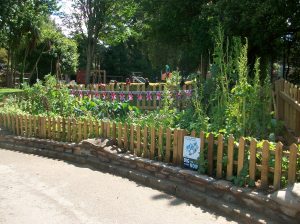


Leave a comment